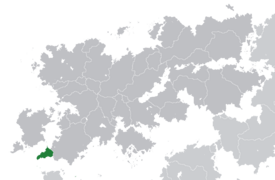Garza
This article is incomplete because it is pending further input from participants, or it is a work-in-progress by one author. Please comment on this article's talk page to share your input, comments and questions. Note: To contribute to this article, you may need to seek help from the author(s) of this page. |
Kingdom of Garza Reino de Garza (Garzan) | |
|---|---|
| Motto: No Me Pisotees ("Don’t Tread On Me") | |
| Anthem: Costa Verdecente” The Verdant Coast | |
 Location of Garza (dark green) – in Belisaria (dark grey) | |
| Political Map of Garza Political Map of Garza | |
| Capital and city | Ciudad Garza |
| Official language and national language | Garzan |
| Recognized languages | |
| Ethnic groups (2018) |
|
| Religion |
|
| Demonym(s) | Garzan |
| Government | Federal parliamentary constitutional monarchy |
• King | Diego IV |
| Marco Roman | |
| Alfonso Vega | |
| Legislature | Cortes |
| Formation | |
• County of Garza | 718 CE |
• Duchy of Garza | 800 CE |
• Independence from Latium | 1060 |
| Currency | Real (gr) (OKR) |
| Date format | dd/mm/yyyy (CE) |
| Driving side | left |
| Calling code | +374 |
| ISO 3166 code | GZ |
| Internet TLD | .gz |
Garza (Garzan: Reino de Garza), officially known as the Kingdom of Garza, is a federal parliamentary constitutional monarchy of nearly 8 million people on the continent of Belisaria. It is bordered by Latium to the west. The official and national language is Garzan.
Garza was originally populated by Garzan tribes who lived along the coast, while Germanic peoples from central Belisaria and Latins from the southwest mingled with the local populace. The area that is Garza today quickly came under the authority of Latin kings and later emperors, which helped establish a Garzan territorial identity and semblance of government.
The early Latin Empire organized Garza initially as a province, and later a duchy as the province grew in power and influence as a trading hub between Latium and the lands further to the east. Garza was able to grow and prosper under Latin rule until the 11th century, when the empire collapsed into civil war and faced foreign invasion. It was at this time that the Duke and Count Palatine of Garza, Alfonso Rodriguez, declared himself King of an independent Kingdom of Garza.
The Kingdom of Garza remained a small, peripheral state in southern Belisaria for centuries, though for most of that history it was able to maintain its independence via a complex network of alliances and treaties. There was a brief period of personal union with Latium as a result of dynastic succession, though this ended as a result of a rebellion led by local nobility, who chose Ferdinand Venegas as king due to his dynastic ties.
Today Garza is a parliamentary democracy and a constitutional monarchy that is both a member of the Forum of Nations. Despite being overwhelming catholic, Garza is secular, as are its government institutions.
History
Geography
Climate
Topography
Flora and fauna
Politics and government
Garza is a federal constitutional monarchy with a democratic parliamentary political system. The Monarch is hereditary and executive, with a bicameral parliament, the Cortes Generales (General Courts). The executive branch consists of a Council of Ministers of Garza presided over by the Prime Minister, nominated and appointed by the king and confirmed by the General Assembly following legislative elections.
The legislative branch is made up of the General Assembly with 200 members, elected by popular vote on block lists by proportional representation to serve four-year terms, and a Senate with 100 seats, appointed by the provincial legislatures. Senators also serve four-year terms.
Garza is a representative democracy with universal suffrage. Membership of the General Assembly is based on proportional representation of political parties. The Government consists of the Prime Minister and the Ministers, with the Prime Minister appointing Ministers who then serve at the Prime Minister’s discretion on the Council of Ministers. The Government is accountable to the General Assembly of the Cortes, which elects the Prime Minister and has the power to dismiss them following a successful vote.
Law and criminal justice
Garza has a civil law system codified in the Constitution, with some institutions inherited from the Latin Empire. Criminal and private law codes are codified at the national level.
As a federation, Garza operates a parallel court system with independent provincial and federal courts. The Supreme Court of Garza is the court of last resort for all civil and criminal appeals matters, while each province has its own supreme court.. The federal court system consists of inferior courts, appeals courts of assidere and the Supreme Court. Most provincial court systems mirror this structure.
Administrative divisions
Garza consists of twenty provinces with varying degrees of autonomy. Each province has its own legislature, governing council and supreme court, the powers of which depend on the province in question. The autonomy of the provinces is wholly dependent upon the discretion of the federal government, which reserves the power to either change or revoke the privileges of the provinces.

